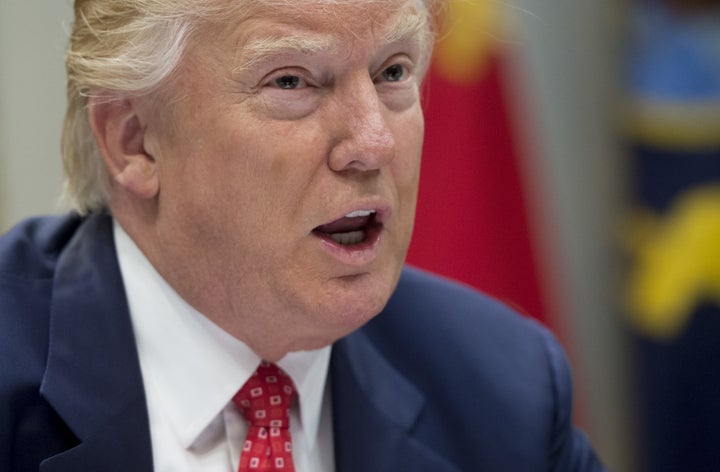WASHINGTON ― More than 100 construction workers die in a typical year in Texas ― many of them immigrants who may speak little or no English and not know their rights on the worksite.
A small, Austin-based nonprofit called the Workers Defense Project has tried to improve this situation. Sixty percent of Texas construction workers said they received absolutely no safety training before starting a job, according to a survey the group released in 2013. So the organization holds free safety training seminars in the Austin and Dallas areas, teaching workers how to avoid falling off buildings, getting hit with heavy machinery or being overcome by heat.
Last year the nonprofit received a modest federal grant of $144,000 to help run its safety program. The budget proposal President Donald Trump put forward last week would eliminate that grant.
The White House said the effectiveness of such funding is “unproven.” But Jose Garza, the executive director of Workers Defense Project, said he has no doubt that the training prevents injuries and saves lives. It also provides a rudimentary education that, in his experience, many employers simply won’t pay for ― even if it saves costs to employers and society in the long run.
“This is a very dangerous industry,” Garza said. “It’s absolutely imperative that everyone on the job site has that basic safety training. If just one person doesn’t, that could have repercussions.”
“This,” he added, “is a very dangerous proposal.”

The White House’s budget blueprint takes an axe to all manner of domestic programs, slashing funding for education, workforce development and assistance to the poor to help pay for a military buildup and a wall along the U.S.-Mexico border. While the budget is ultimately determined by Congress, the president’s proposal serves as a guide for how the administration sees the role of government and how it plans to run its agencies. It also tees up the specific funding fights that will unfold between Democrats and Republicans on Capitol Hill.
The individual programs on Trump’s chopping block represent a tiny piece of the overall budget. The safety grants that go to groups like Garza’s ― known as the Susan Harwood Training Grant Program, administered by the Labor Department ― costs around $10.5 million a year. By getting rid of it, the White House would cut a whopping 0.0002 percent of the overall budget, according to the budget calculator from the Center for Economic and Policy Research.
Like many other programs facing cuts from Trump and the Republican Congress, the elimination of the Harwood grants would provide a barely perceptible savings to the federal government, while hurting vulnerable workers in unseen ways. Setting aside the value of human life, it’s possible cutting the program could even cost money in the long run, through higher workers compensation and health care costs borne by employers and, well, all of us.
That’s why backers of the grants see them as an investment rather than an outlay.
“The program is tiny, but very cost-effective,” said David Michaels, who served as the head of the Occupational Safety and Health Administration under former President Barack Obama, and teaches public health at George Washington University. “It’s for small employers and for workers, but especially vulnerable workers. I have no question [the grants] are very valuable and play an important role in protecting people.”
The Harwood money is specifically devoted to people working in dangerous and low-wage industries, where injury rates are high and employer-provided training tends to be insufficient. It is as much a subsidy to businesses as it is to groups like Workers Defense.
Last year’s grants helped fund training for New York City nail salon workers, who are exposed to dangerous chemicals on a daily basis; construction workers who live on tribal lands; Georgia poultry workers who face extraordinarily high levels of carpal tunnel syndrome; migrant farm workers in Virginia who handle pesticides and often don’t speak English; and tree-trimmers in the Northeast who are liable to fall from heights or have mishaps with heavy machinery, among others.
“It’s absolutely imperative that everyone on the job site has that basic safety training. If just one person doesn’t, that could have repercussions.”
- Jose Garza, director of the Workers Defense Project
Some of the grants go to labor unions ― a prime target of Republicans ― but the money must be used toward working safety and training, areas that unions specialize in. Most of the grants go to universities or colleges, trade groups, public-interest groups and nonunion worker centers. The program has been running since 1978 and trained more than 2 million workers, according to the Labor Department. A typical grant last year was around $130,000.
Although Trump’s budget explicitly questioned the value of safety training, research has found that training workers in how to be safe on the job can both prevent injuries and save money.
A 2004 study in the Journal of Occupational and Environmental Medicine analyzed workers compensation and health insurance data, finding that trained construction workers were 12 percent less likely than nontrained workers to file a workers comp claim. Among the youngest workers, safety training could reduce claims by 42 percent, the authors wrote.
And low-wage workers who’d received safety training were “significantly less likely to experience work-related injuries,” according to a 2015 report that UCLA prepared for California’s labor department.
“Unfortunately, training can be a luxury. We’ve got small rural departments out there with minimal funding to keep them going.”
- Elizabeth Harman, International Association of Firefighters
One of last year’s grants went to the International Association of Firefighters, a union representing 300,000 firefighters and paramedics. Elizabeth Harman, who oversees training grants for the union,, said the group has been using the $140,000 grant to redevelop its training program for working in confined spaces, one of the most dangerous situations any worker can face.
Harman pointed to the January tragedy in Key Largo, Florida: Three utility workers died in a manhole after being overcome by poisonous fumes, and a firefighter was left in critical condition after trying to save them. The target audience for the training is firefighters in cash-strapped rural areas, Harman said, adding that the program benefits both nonunion and union workers.
“Unfortunately, training can be a luxury,” Harman said. “We’ve got small rural departments out there with minimal funding to keep them going.”
Harman said the union had to develop a detailed plan when it applied for the grant, and it files quarterly reports to the government on how it’s been using the money. She noted that the union often secures much larger grants from the government to fund training.
“This is a small grant for us, but sometimes the smallest grants have the largest impact,” she said.
Garza said Workers Defense will find a way to make up the shortfall if it can’t rely on the Harwood grant in the future. The majority of the group’s funding comes from foundations, individual donations, unions and member dues, and only a small portion through government grants. But he said Trump’s willingness to cut training for low-wage workers in dangerous industries violated his campaign promise to make work great again.
“He went around the country talking about bringing back good jobs for American workers,” Garza said. “We’ve just seen mounting evidence that he’s cutting programs that give those folks a chance to have good-faith jobs.”
How will Trump’s first 100 days impact you? Sign up for our weekly newsletter and get breaking updates on Trump’s presidency by messaging us here.


